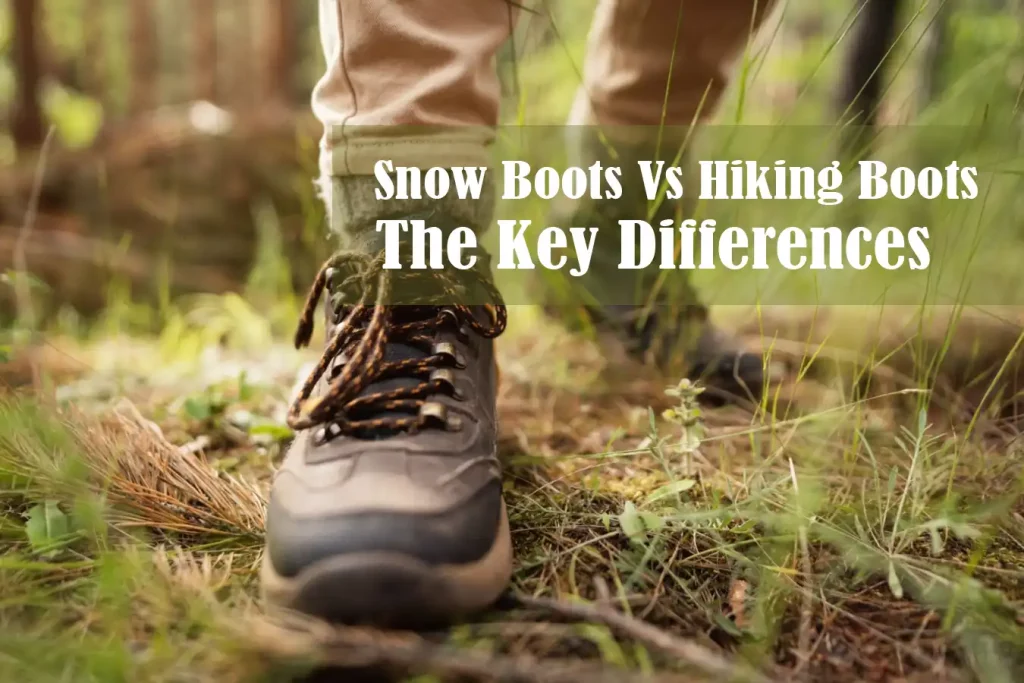“Snow boots vs hiking boots – it’s a debate many outdoor enthusiasts, like me, Ovi Tanchangya, have had over campfire chats.
As an outdoor enthusiast, I know how critical it is to choose the right footwear for the occasion.
The purpose of this article?
To dive deep into the key differences between snow boots and hiking boots.
So if you’re gearing up for an adventure and aren’t sure which to pick, stick around.
Expect a comprehensive, engaging, and user-friendly guide that will help you make an informed decision.
Understanding the Boot Basics
To truly understand the distinctions between snow boots and hiking boots, we must first unravel the components that make up a boot. Read onto learn.
Anatomy of a Boot
Let’s dissect a boot to understand its functionality:
Outsole
The outsole is the boot’s bottom part, which contacts the ground directly. It’s responsible for grip and traction. A boot with a sturdy, well-treaded outsole ensures you stay upright on slippery, uneven, or challenging terrains.
Midsole
The midsole is sandwiched between the outsole and the insole, providing cushioning and shock absorption. It’s crucial for comfort during long hikes or walks in the snow.
Insole
Often removable, the insole is the interior bottom of the boot. It offers extra comfort and support, molding to your foot over time.
Upper
The upper is the top part of the boot that encases the foot and ankle. It’s usually constructed with materials offering varying degrees of breathability, durability, and water resistance.
Now, how does all this anatomy apply to the difference between snow boots and hiking boots? Let’s find out!
Snow Boots: An Overview
The winter wonderland calls for a certain kind of footwear, something that offers more warmth, grip, and protection against the snowy, icy conditions – enter the snow boots. Let’s delve into what these boots are all about.
Definition and Purpose of Snow Boots
Snow boots are designed specifically for cold and wet winter conditions. They focus on warmth, water resistance, and foot and ankle protection from harsh winter elements. The primary purpose of a snow boot is to keep your feet warm, dry, and cozy while providing excellent traction on snowy or icy surfaces.
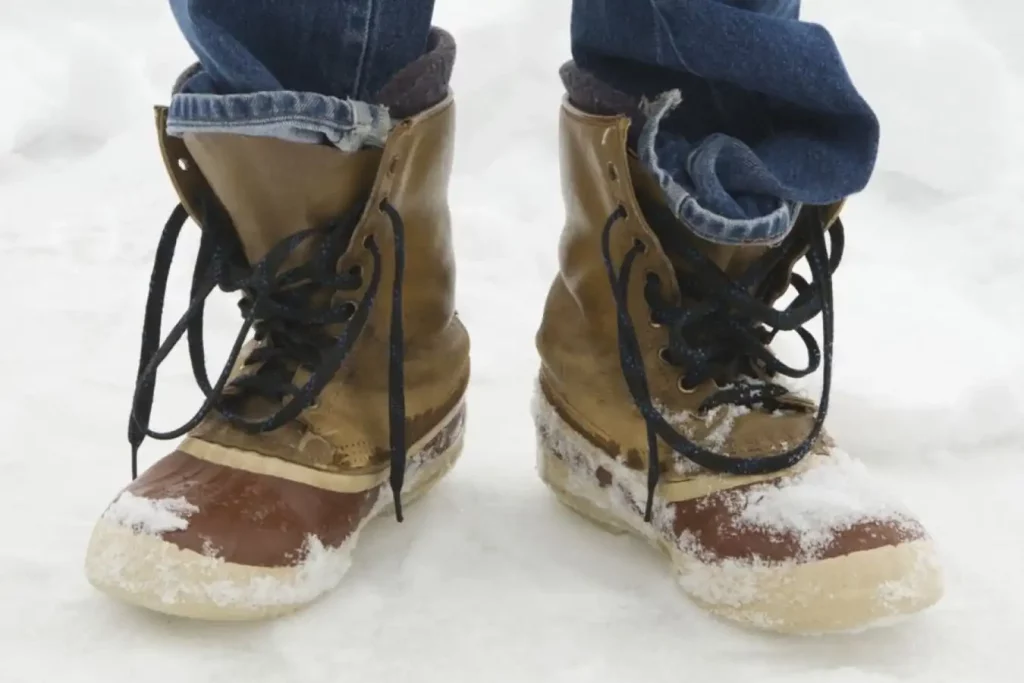
Key Features of Snow Boots
Snow boots come with certain unique features that make them ideal for winter conditions:
- Insulation: To combat the freezing temperatures, snow boots have extra insulation typically made from synthetic materials, wool, or even down feathers.
- Waterproofing: Most snow boots are waterproof to prevent snow and water from seeping in, keeping your feet dry.
- High Shaft: They have a high shaft to prevent snow from entering the boot and provide extra warmth.
- Deep Lugs and Grippy Outsole: Snow boots usually have deep lugs and a rubber outsole for better traction on snowy and icy surfaces.
Pros and Cons of Snow Boots
Like any footwear, snow boots come with their advantages and disadvantages:
Pros:
- Excellent insulation ensures warm feet.
- Waterproofing keeps your feet dry.
- Deep lugs provide good traction on icy and slippery surfaces.
Cons:
- They can be too warm for non-winter conditions.
- Usually heavier, making them less ideal for long walks or hikes.
- Lack the flexibility and snug fit of a typical hiking boot.
Ideal Conditions and Activities for Snow Boots
Snow boots are the champions of cold, wet, and slippery conditions. They are best suited for snowy landscapes, icy paths, and frigid winter days. Whether you’re shoveling your driveway, taking a stroll in a winter wonderland, or building a snowman with the kids, insulated snow boots are your best friends in these scenarios.
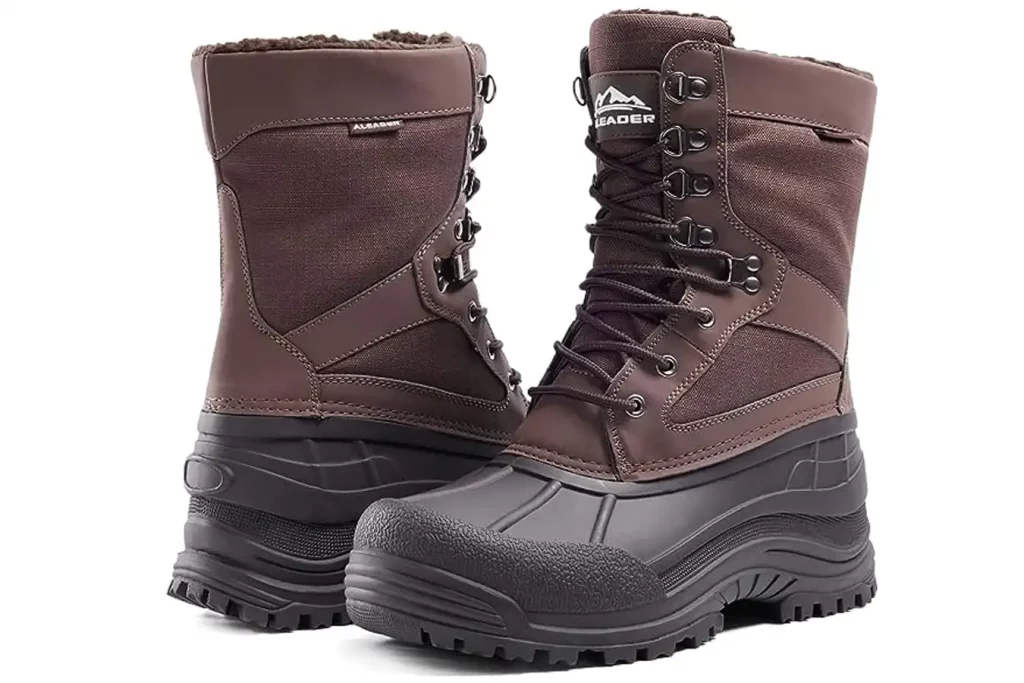
However, if you’re planning on a multi-day winter hike over rugged terrain, you might want to consider waterproof hiking boots for better support and mobility.
Hiking Boots: An Overview
Let’s shift our focus to another special kind of footwear – the hiking boots.
Definition and Purpose of Hiking Boots
Hiking boots are designed for a wide range of outdoor activities. From simple day hikes to multi-day treks, these boots are meant to keep your feet comfortable and protected. When tackling uneven trails, ankle support hiking boots are a preferred choice for many outdoor enthusiasts.
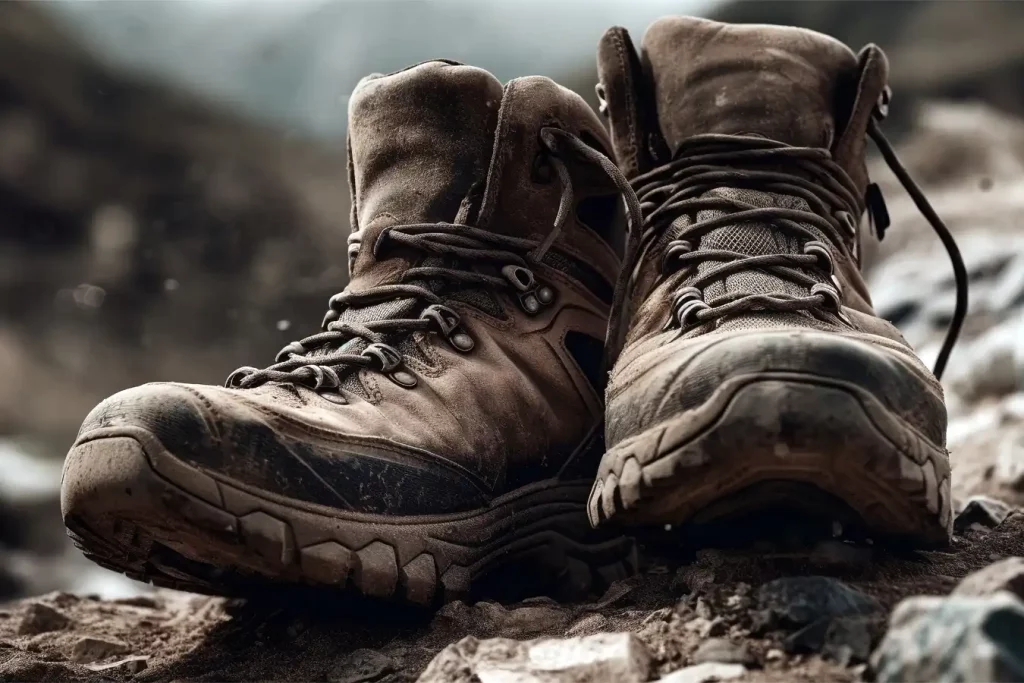
The primary purpose of hiking boots is to provide excellent support, stability, and traction on a variety of terrains, while ensuring a comfortable fit for long-duration use. Mountaineering boots, while heavy and more rigid than many hiking boots, provide unparalleled versatility in challenging terrain filled with packed-in snow.
Key Features of Hiking Boots
- Supportive Upper: Made from materials like leather or synthetics for durability, the upper part of the boot provides support to the ankle and helps keep out debris.
- Stiff Midsole: This is designed to shield your feet from being punctured by sharp rocks or roots and to offer some cushioning.
- Grippy Outsole with Deep Lugs: This aids in traction over wet or uneven surfaces.
- Padded Insole: It adds cushioning for comfort during long walks.
Pros and Cons of Hiking Boots
Pros:
- They offer excellent ankle support, important for carrying heavy loads and preventing injuries.
- Versatile for different types of trails and seasons.
- Wearing hiking boots on long-distance trails ensures proper support and comfort for the feet.
Cons:
- Some models can be heavy, which might lead to quicker fatigue.
- They require a “breaking in” period for ultimate comfort.
- Not always the best option for winter conditions without proper insulation.
Ideal Conditions and Activities for Hiking Boots
Hiking boots are ideal for hiking trails, mountain trekking, backpacking trips, and general outdoor adventures. They can handle a variety of terrains – from soft dirt trails to rocky surfaces. And yes, they can tackle mild winter conditions too, provided they’re properly insulated and waterproofed.
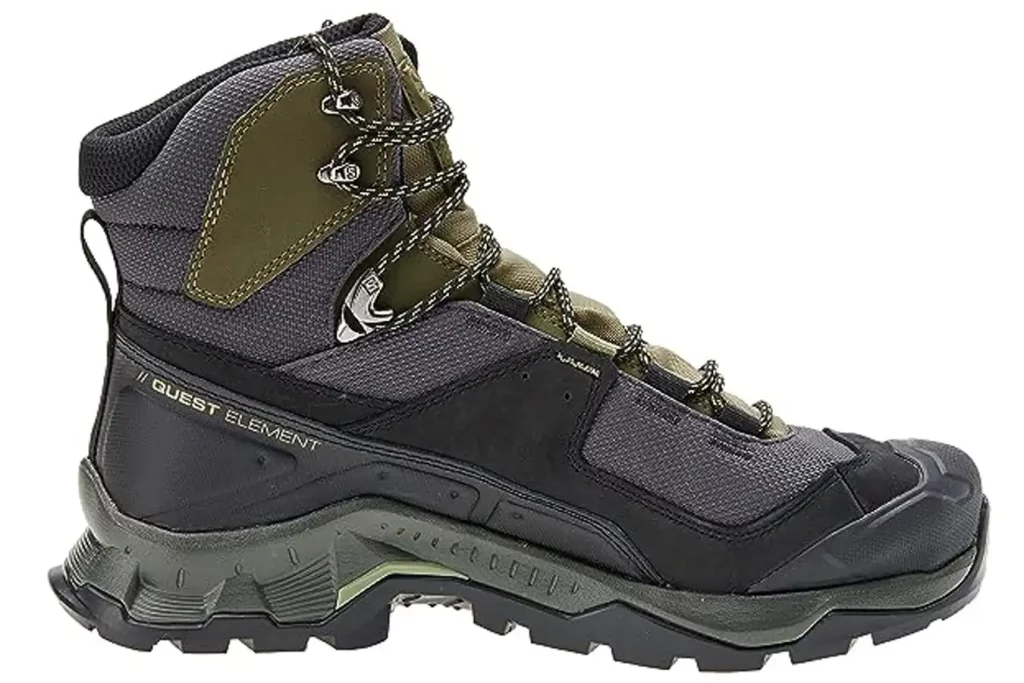
However, for deep snow and extreme cold, you might want to stick to snow boots or get an insulated pair of hiking boots.
Read more: Mountaineering Boots Vs Hiking Boots
Snow Boots Vs Hiking Boots: Key Differences
It’s time to clear the air. Snow boots or hiking boots?
Material and Design: Snow Boots Vs Hiking Boots
Snow boots are designed to keep your feet warm and dry in cold and snowy conditions. They are typically made from waterproof materials, and they have thick insulation to keep your feet warm. They are designed to be comfortable and easy to put on and take off. In contrast, snow boots tend to favor insulation and waterproofing, often sacrificing breathability in the process.
On the other hand, hiking boots are designed to be durable and provide excellent support and protection on a variety of terrains. They are from sturdy materials, such as leather or synthetic blends, and they have less insulation but offer better breathability.
Warmth and Insulation: Snow Boots Vs Hiking Boots
When it comes to warmth and insulation, snow boots take the lead. They are specifically designed to protect against cold and snowy conditions with their heavy insulation and heat-reflective lining.
Hiking boots can also offer warmth, but their insulation is usually less than that of snow boots. Instead, they focus on breathability to prevent your feet from sweating, which can lead to discomfort and blisters during long hikes.
Waterproofing and Breathability: Snow Boots Vs Hiking Boots
Snow boots excel in providing excellent waterproof capabilities, essential for stomping through deep snow. However, they often lack breathability due to their focus on insulation.
Hiking boots, in contrast, strike a balance between waterproofing and breathability.
Traction and Grip: Snow Boots Vs Hiking Boots
Snow boots are designed with soles that can grip on snow and ice, making them ideal for winter conditions. Hiking boots also offer excellent traction, but they are designed to grip a variety of terrains, from rocks to mud, and may not perform as well on snow or ice.
Comfort and Fit: Snow Boots Vs Hiking Boots
Both types of boots aim to offer comfort, but the fit can differ. Snow boots often have a roomier fit, perfect for thick, warm socks. Hiking boots tend to have a snugger fit to provide better support and control during hikes. They also often include lacing systems for a customizable fit.
Durability and Lifespan: Snow Boots Vs Hiking Boots
Durability is where hiking boots shine. They are designed for rugged terrains and frequent use, so they typically have a longer lifespan. Snow boots are durable in cold weather conditions, but they may not stand up to rough terrains or frequent use as well as hiking boots.
Here’s a snow boots vs hiking boots comparison table highlighting the key differences:
| Feature | Snow Boots | Hiking Boots |
| Material and Design | Designed for cold, wet conditions | More versatile design for various terrains |
| Warmth and Insulation | High insulation for extreme cold | Insulation varies, often less than snow boots |
| Waterproofing | Highly waterproof | Varies, can be waterproof or water-resistant |
| Breathability | Less focus on breathability | Generally more breathable |
| Traction and Grip | Made for icy or snowy surfaces | Designed for traction on various terrains |
| Comfort and Fit | Focus on warmth, might be bulkier | Focus on support and comfort during long hikes |
| Durability and Lifespan | Durable in cold conditions | Built for durability across different terrains |
This table succinctly summarizes the distinctions and can help a reader to understand the basic differences and make an informed decision based on their needs.
Learn more: Hiking Boots Vs Work Boots
Climate and Terrain Considerations
When it comes to choosing between snow boots and hiking boots, the climate and terrain where you’ll be using them play crucial roles. Let’s break it down.
Climate Factors
Temperatures
Cold temperatures call for warm, insulated boots – this is where snow boots excel. Their thick insulation and waterproof materials are ideal for keeping your feet warm and dry in low temperatures. Conversely, in mild or warm temperatures, the breathable materials and less insulation of hiking boots are more suitable.
Precipitation
If you’re dealing with heavy snow or rain, the waterproof properties of snow boots are key. However, if you’re likely to face a light drizzle or sporadic showers, the waterproof yet breathable design of hiking boots will serve you better.
Seasonal Changes
Winter months might require the warm and snug comfort of snow boots, especially in areas with heavy snowfall. In contrast, hiking boots are versatile and can handle multiple seasons – spring’s muddy trails, summer’s dry paths, or fall’s leaf-covered tracks.
Terrain Factors
Flat vs. Mountainous
For flat terrain, either boot could serve well, depending on the weather conditions. But for mountainous, uneven terrain, the robust construction, ankle support, and excellent traction of hiking boots make them the ideal choice.
Dry vs. Wet
Dry terrains can be navigated easily with hiking boots, as their breathable material helps keep feet dry from perspiration. Wet or snowy conditions lean more towards the waterproof and insulated design of snow boots.
Urban vs. Wilderness
If you’re planning to use your boots in an urban setting with cleared paths, either type could work, although the comfort and style of snow boots might be preferred. But for the unpredictability of the wilderness, hiking boots provide the support, durability, and traction necessary to keep you moving forward.
In short, selecting the right footwear can make all the difference in your outdoor experience. Consider your climate and terrain, and let those guide your choice between snow boots and hiking boots. As always, it’s about finding the right tool for the right job!
However, if you’re heading into rocky and steep terrain, you might want to opt for hiking boots with strong traction and ankle support.
Usage Scenarios: Snow Boots
Snow boots are a versatile piece of winter gear that can serve in a variety of situations. Let’s look at some common scenarios where these boots really shine.
Winter Hiking
Snow boots provide excellent warmth and protection against the elements during winter hikes. Their deep tread offers superb traction on snowy surfaces, and their waterproof construction ensures your feet stay dry throughout your journey. In winter weather, snow boots are typically preferred due to their enhanced insulation and waterproofing, making them suitable for snowy and icy conditions.
Snow Shoveling
When it comes to clearing snow from your driveway or sidewalk, a pair of snow boots can make the job a lot more comfortable. Their high insulation provides warmth, while their waterproof materials keep your feet dry amidst the wet snow. Plus, their robust build ensures durability, even with repeated use. When facing wet or slushy terrain, waterproof boots, such as many snow boots, provide the necessary protection to keep feet dry and comfortable.
Winter Sports (Skiing, Snowboarding, Snowmobiling)
While specific sports like skiing and snowboarding have their specialized footwear, warmth snow boots are perfect for the times you’re off your skis or board.
Whether you’re navigating a snowy lodge area or hopping on a snowmobile for a scenic tour, the warmth, traction, and water-resistance of snow boots are undeniable assets. Many snow boots are crafted with insulation and waterproofing to keep feet warm and dry in winter conditions.
Usage Scenarios: Hiking Boots
Hiking boots are the go-to footwear for many outdoor enthusiasts. Here’s why they’re favored in various scenarios:
Long-Distance Hiking
Hiking boots are specifically designed for long treks. Their solid construction offers excellent support, reducing the risk of ankle injury on uneven terrain. If you’re planning a long-distance hike or a backpacking trip in rough terrain, it’s essential to wear hiking boots for proper support and comfort.
Rock Climbing
While not a replacement for dedicated climbing shoes, hiking shoes can handle scrambles and low-grade climbs with ease. Their high ankle support and strong traction make them suitable for navigating rocky terrains. Most hiking boots are designed to provide excellent traction and support for varied terrains.
Backpacking and Wilderness Excursions
If you’re on a multi-day trip into the wilderness, carrying heavy backpacks, hiking boots are your best friend. Their sturdy build supports the additional weight, and their durability ensures they can withstand the rigors of the wilderness.
Remember, while both snow and hiking boots have their distinct strengths, they’re most effective when used in their appropriate scenarios. It’s all about choosing the right boot for the right situation!
FAQs about Hiking Boots Vs Snow Boots
Can I use my snow boots as hiking boots?
Do you wear snow boots or hiking boots with snowshoes?
What is the difference between normal boots and snow boots?
Are snow boots good for walking on ice?
To Sum it up
There you have it, a comprehensive comparison between snow boots and hiking boots, covering everything from their basic structure and features to their optimal usage scenarios.
Both types of boots have their distinct advantages and applications, so it’s crucial to consider the nature of your activity, weather and wet conditions, personal comfort, and budget before making a purchase.
So, are you ready to step into the wild with the right pair of boots? Whether it’s a snowy mountain peak or a rocky forest trail, rest assured that your feet will be well-protected and comfortable, ready to carry you through nature’s grandeur. Lace up, and let’s venture outdoors!

